Now I'll write the article following the specific structure requested with introduction (max 100 words), 20 H2 sections (100-120 words each), and conclusion (max 100 words).Composite decking has revolutionized outdoor living spaces by offering the natural beauty of wood without the high maintenance requirements. These innovative materials combine durability, sustainability, and design flexibility to create stunning outdoor environments that withstand the elements while maintaining their aesthetic appeal for decades. From eco-friendly materials to smart pergolas and multi-level layouts, these stylish, low-maintenance upgrades will transform your deck into a functional and inviting space. Manufacturers offer composite decking in a wide range of colors and styles. Many of them mimic the look of natural wood but without the hassle of continued maintenance. Whether you're planning a complete deck renovation or designing a new outdoor space, these composite deck ideas will inspire you to create a personalized retreat that enhances your home's value and your quality of life.
1. Composite Deck Picture Frame Design
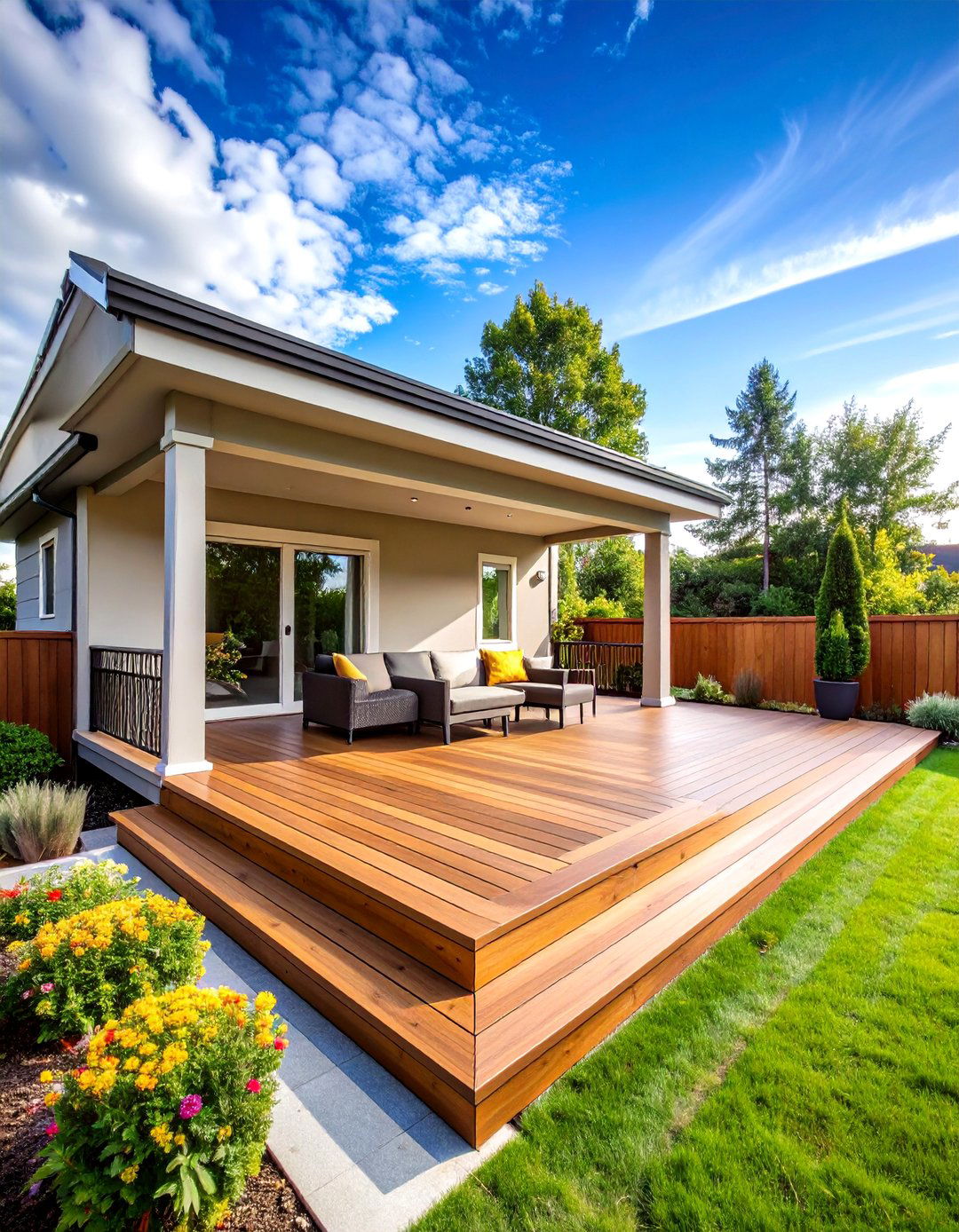
A Picture Frame deck pattern is a simple, affordable design that creates a "frame" around the deck's edges using decking boards. This timeless composite deck approach uses contrasting board colors or textures to create a sophisticated border that resembles a picture frame surrounding your main deck surface. The technique involves installing perimeter boards perpendicular to the main deck boards, creating clean lines that define the space beautifully. Add impact to a picture frame design by choosing edges in a contrasting color, or use multi-width boards to create a frame that's two or three boards wide. Beyond aesthetics, this composite deck pattern offers practical benefits by protecting board ends from weather exposure and creating a finished appearance that elevates your entire outdoor space while requiring minimal additional materials or complex installation techniques.
2. Composite Deck Herringbone Pattern

Creating a stunning herringbone composite deck pattern transforms your outdoor space into a luxurious retreat that commands attention. Herringbone patterns are best suited for professionals. Choose a contractor you trust and discuss how you can elevate your design with complementary colors or play with different widths for a custom look. This intricate design features short deck boards laid at 45-degree angles to form repeating V-shaped patterns that create exceptional visual movement and texture. Due to the intricacy of its pattern, a herringbone deck will need additional substructure support with appropriate joist spacing and blocking at the time of installation. The sophisticated basketweave appearance works particularly well with larger composite deck surfaces where the pattern has sufficient space to repeat and showcase its elegant complexity, making it an ideal choice for homeowners seeking a premium, designer-quality outdoor living space.
3. Composite Deck Diagonal Board Layout
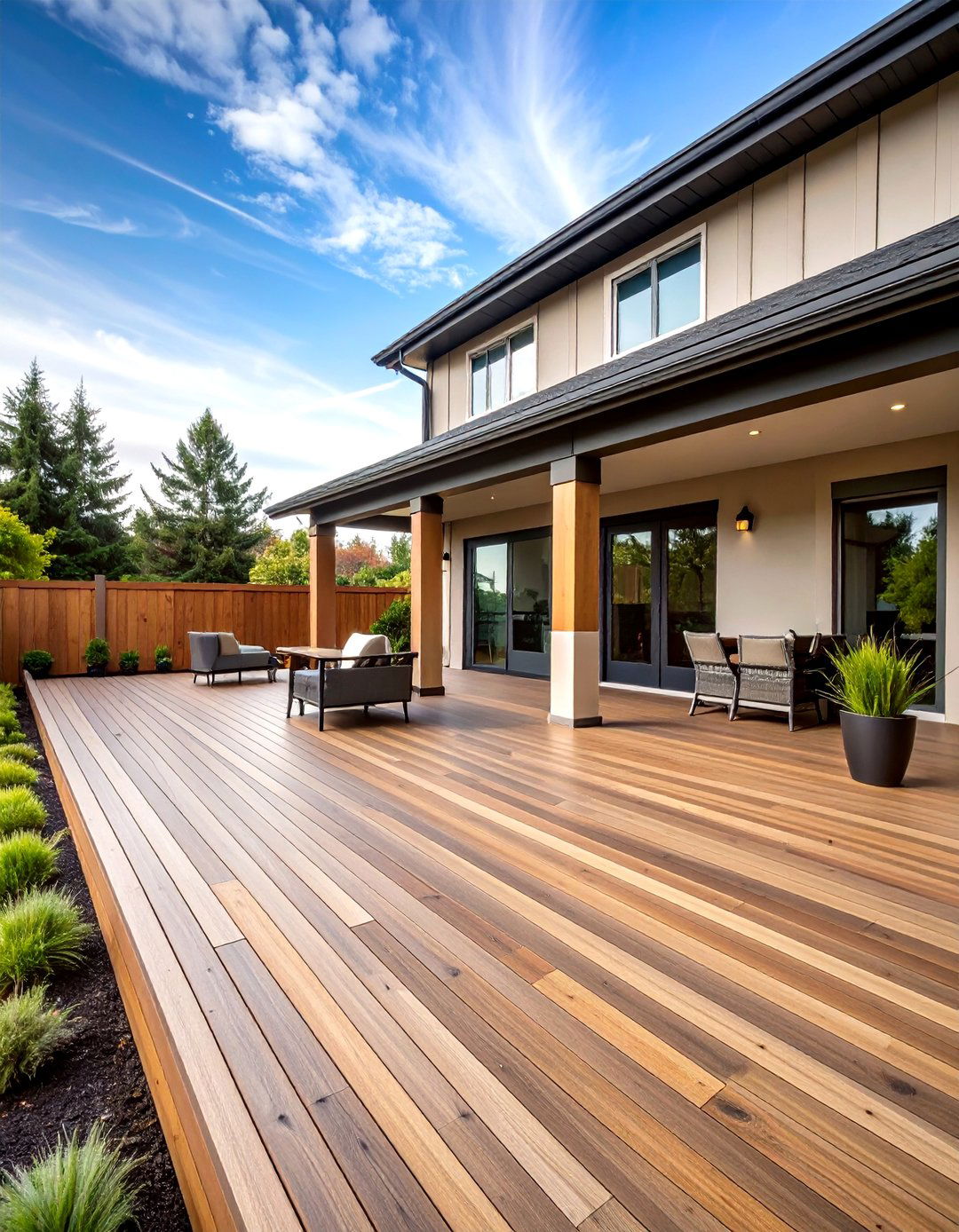
Diagonal composite deck board installations create dynamic visual interest while offering practical structural advantages for your outdoor space. A Diagonal deck pattern sets the boards at a 45-degree angle to the deck frame for a sleek, modern look. This contemporary approach makes spaces appear larger by drawing the eye outward and adding movement to otherwise static surfaces. Using diagonal decking increases the strength of the deck frame, which prevents racking and makes installing sway bracing unnecessary. The angled installation requires careful planning and potentially closer joist spacing to properly support the diagonal span, but the results justify the extra effort. Diagonal and herringbone patterns create movement, drawing the eye outward and making a deck appear larger. This composite deck design works exceptionally well with modern architectural styles and creates stunning focal points when combined with contrasting border treatments.
4. Composite Deck Multi-Level Design
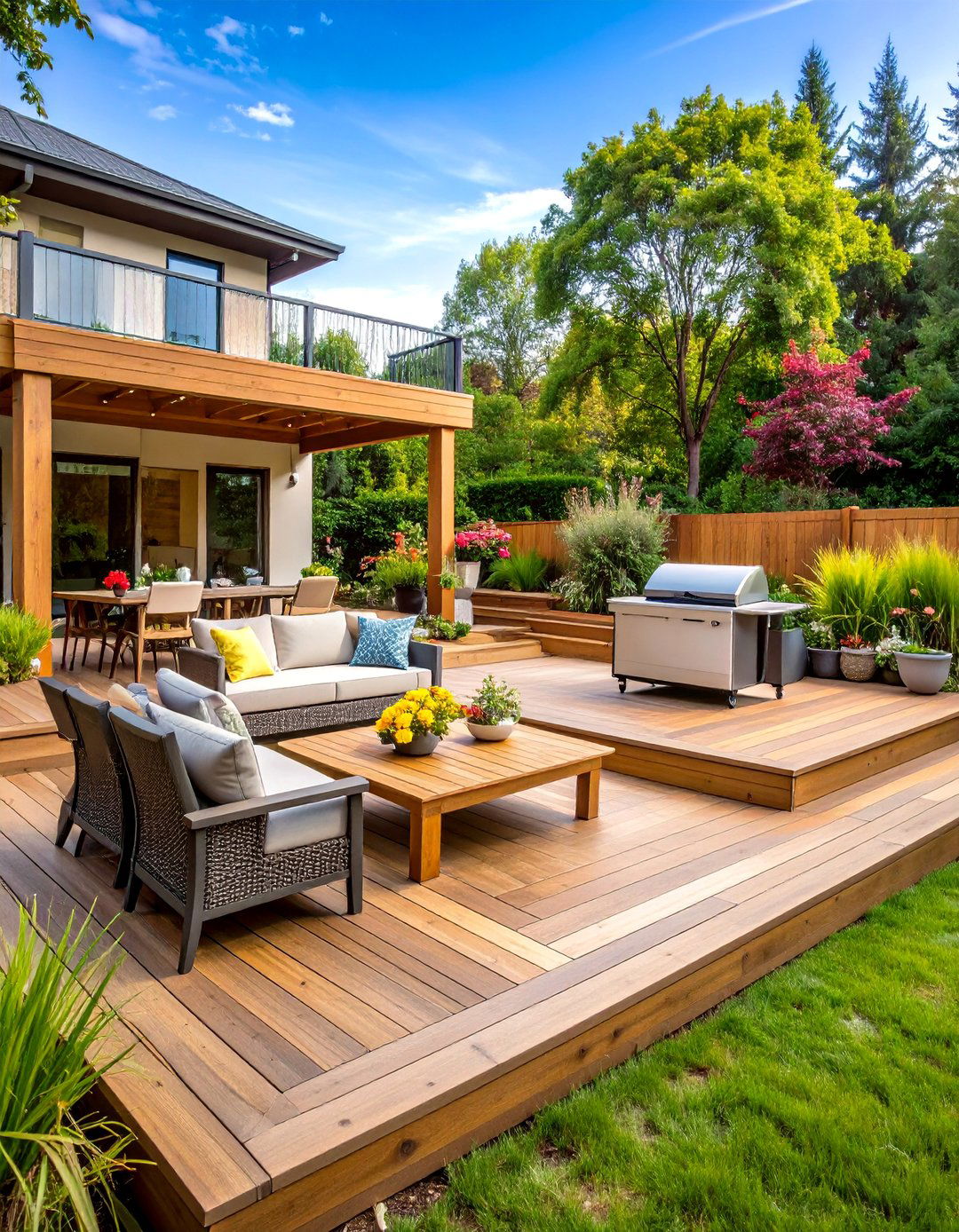
Multi-level composite deck designs maximize outdoor living potential by creating distinct zones for various activities while adding architectural dimension to your property. Multi-level decks allow you to maximize your outdoor living space, creating distinct areas for various activities. By incorporating multiple tiers, you can design dedicated spaces for dining, lounging, grilling, or even a cozy reading nook. These versatile designs work particularly well on sloped lots where different elevations can be integrated naturally into the landscape. By incorporating innovative design elements, such as terraced levels, curved stairs, or built-in seating, you can create a truly unique and captivating deck that reflects your style and meets your needs. The composite materials' consistency and durability make them ideal for complex multi-level constructions, as they maintain their appearance and structural integrity across different elevations while providing seamless transitions between activity areas.
5. Composite Deck with Curved Accents

Curved composite deck accents introduce organic flowing lines that soften traditional geometric designs and create spectacular focal points. Curved deck accents add an instant "wow" factor. The TimberTech Advanced PVC line is made from innovative, capped polymer material that allows for heat bending. These graceful curves can be incorporated into seating areas, dining platforms, or even main deck perimeters to create unique architectural interest. It takes a little more creativity to plan a deck with curves, but the payoff is spectacular. Trex composite decking boards and composite and metal railings can be curved to suit most design needs. The heat-bendable properties of advanced composite materials make curved installations more achievable than traditional wood, allowing for circular seating arrangements or flowing transitions between different deck levels. Professional installation is recommended for complex curved composite deck designs to ensure proper structural support and achieving the desired aesthetic effect.
6. Composite Deck Outdoor Kitchen Integration

Integrating an outdoor kitchen into your composite deck design creates the ultimate entertaining space that extends your home's functionality into the outdoors. An outdoor kitchen set-up can fulfill your dreams of entertaining guests while creating multi-course masterpieces on a chef-quality grill on warm summer days. Adding an outdoor kitchen can also increase your home's resale value. Composite decking provides an ideal foundation for outdoor kitchens due to its resistance to heat, moisture, and staining. When designing an outdoor kitchen space, keep in mind that you'll want to allow enough space between the cooking and seating areas to ensure the cook has room to work. The low-maintenance nature of composite materials makes them perfect for areas prone to spills and heavy use. Consider incorporating complementary composite elements like built-in countertops, backsplashes, and storage solutions that match your decking for a cohesive, professional appearance.
7. Composite Deck Fire Feature Integration
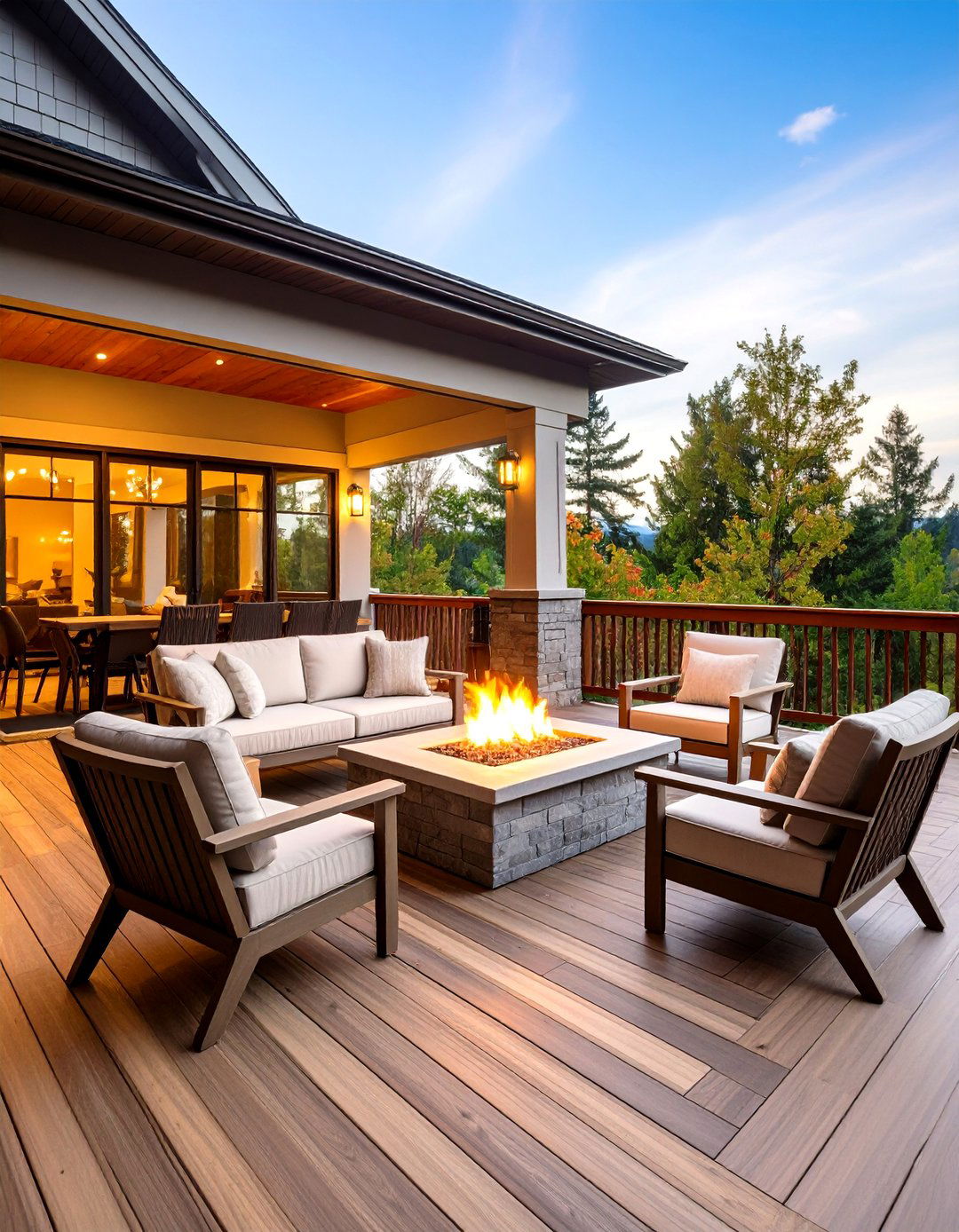
Fire features transform composite decks into cozy gathering spaces that extend outdoor living well into cooler seasons and evening hours. Fire features such as fire bowls and statement fireplaces are a great way to create a focal point on your deck, adding both visual interest and functional warmth. These installations range from built-in fire pits with surrounding seating to elegant fireplace structures that anchor entertainment areas. Fire features are all the rage. Not only do they extend the use of your outdoor space but they create a pleasing atmosphere. If you've got the room, craft a bench around a fire pit using Trex composite deck boards. The heat-resistant properties of quality composite decking make it compatible with fire features when proper safety clearances are maintained. Consider incorporating fire-resistant materials around the immediate fire area while using composite decking for surrounding seating and walkway areas to create a seamless, functional outdoor room perfect for entertaining.
8. Composite Deck Built-in Seating
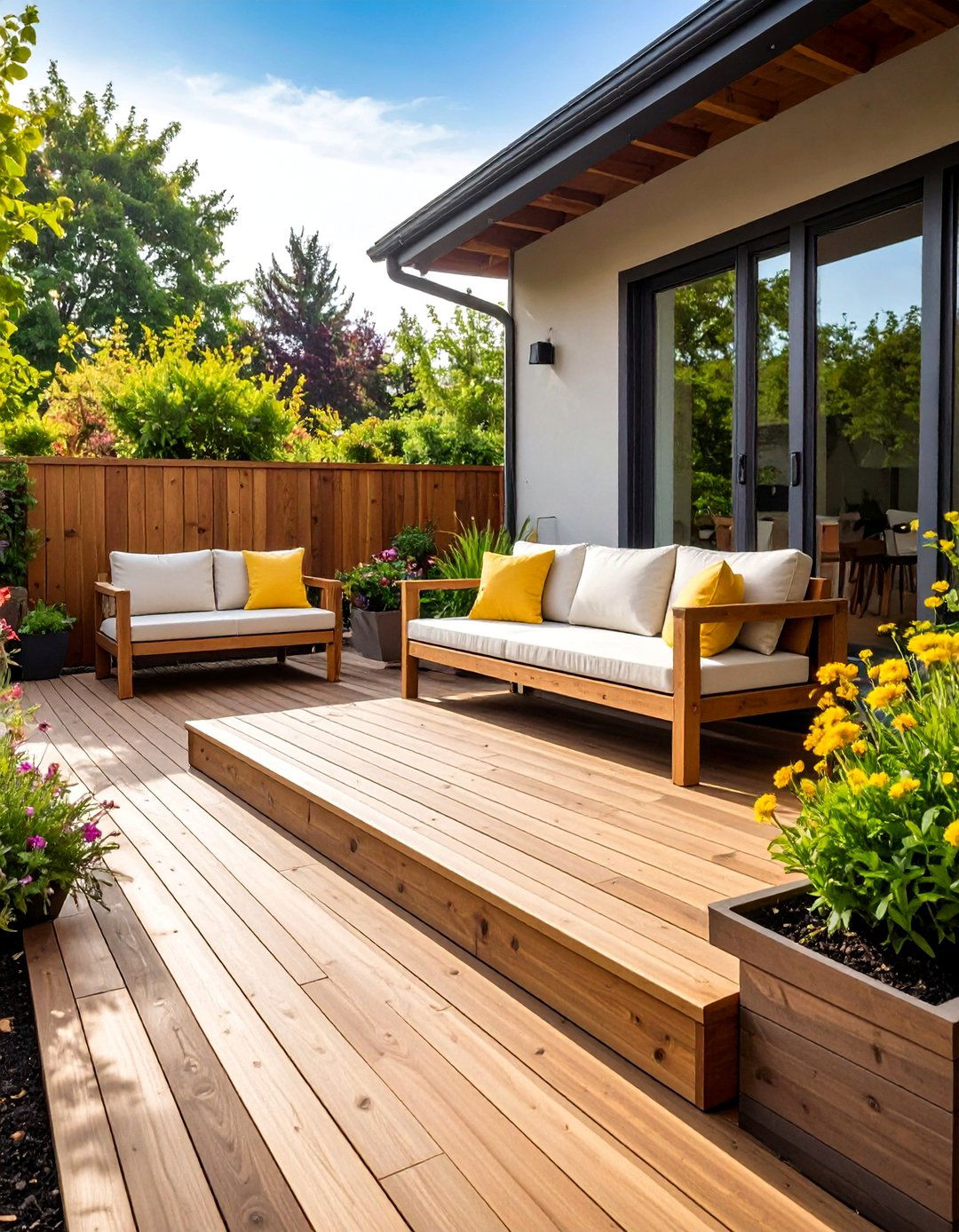
Built-in composite deck seating creates permanent, weather-resistant furniture that maximizes space efficiency while maintaining design cohesion throughout your outdoor area. Built-in benches are permanent furniture that lasts as long as your deck – 25 years or more! A standard bench is an affordable feature that provides extra seating without blocking the view. These integrated seating solutions can include hidden storage compartments for cushions, tools, or outdoor accessories, adding functionality beyond simple seating. Integrated Seating and Storage: Built-in benches with hidden compartments offer comfortable seating and extra storage for cushions, tools, or toys, keeping your deck organized and tidy. The seamless integration of built-in seating using matching composite materials creates clean lines and eliminates the need for separate furniture that requires maintenance or seasonal storage. Consider incorporating curved seating around fire features or straight benches along deck perimeters to define spaces while providing practical seating solutions.
9. Composite Deck Lighting Integration
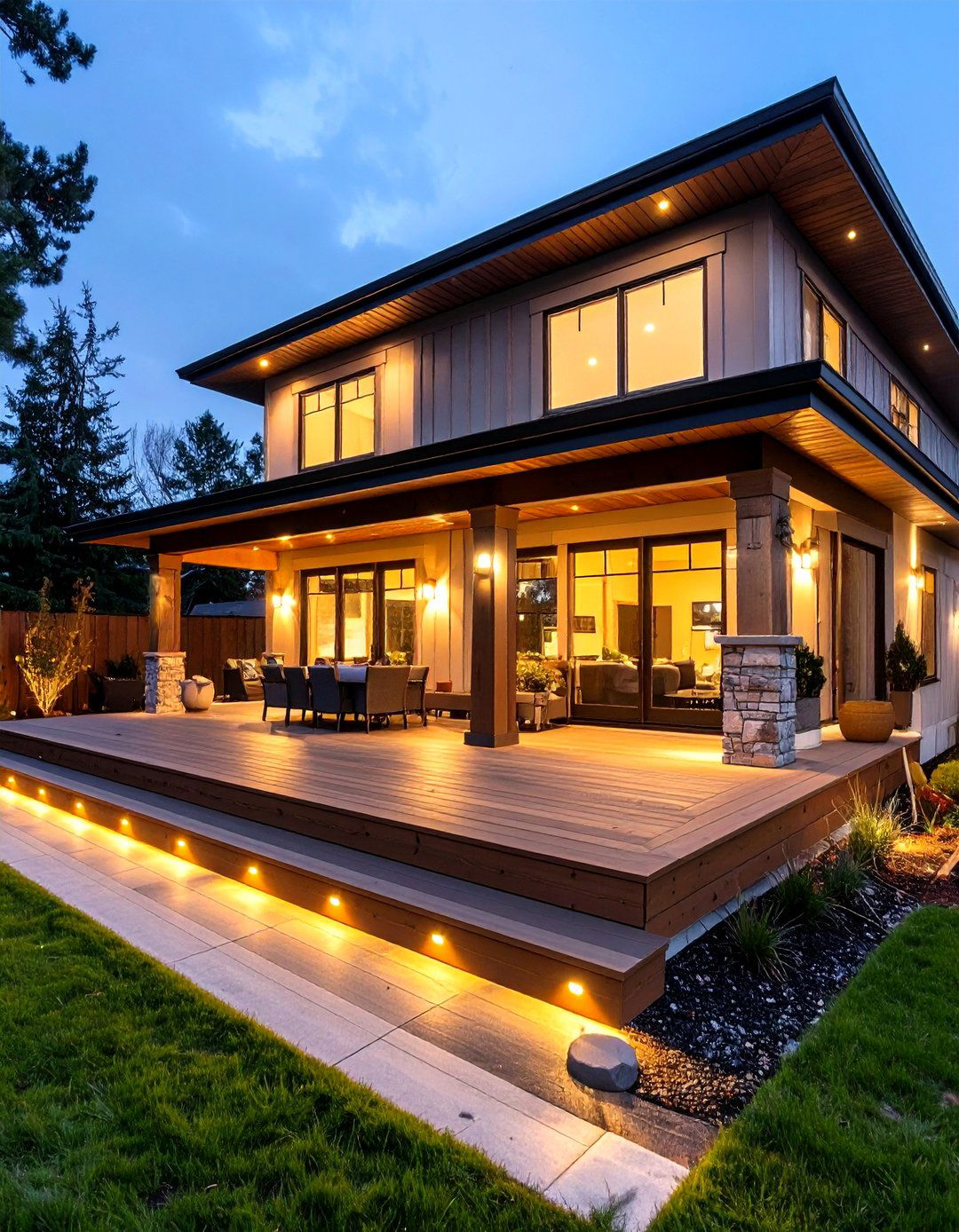
Strategic lighting integration transforms composite decks into enchanting evening retreats while enhancing safety and extending usable hours of your outdoor space. Recessed deck lights: Installed directly into composite deck boards, recessed deck lights bring a special ambiance to your outdoor space. Modern composite decking systems offer various built-in lighting options including post cap lights, step lights, and under-rail illumination that create dramatic effects. Enhanced Safety: Recessed step lights and post-cap lighting illuminate walkways and stairs, preventing trips and falls while blending seamlessly into the deck's design. The integration possibilities include warm LED strips under handrails, elegant post cap fixtures, and discrete step lighting that guides traffic flow. From string lights to recessed LEDs, deck lighting can create a welcoming atmosphere. Creative lighting can add to the charm of outdoor living and extend the use of your deck into the night. Professional installation ensures proper electrical connections while maintaining the weather-resistant qualities of your composite deck system.
10. Composite Deck Pergola Addition
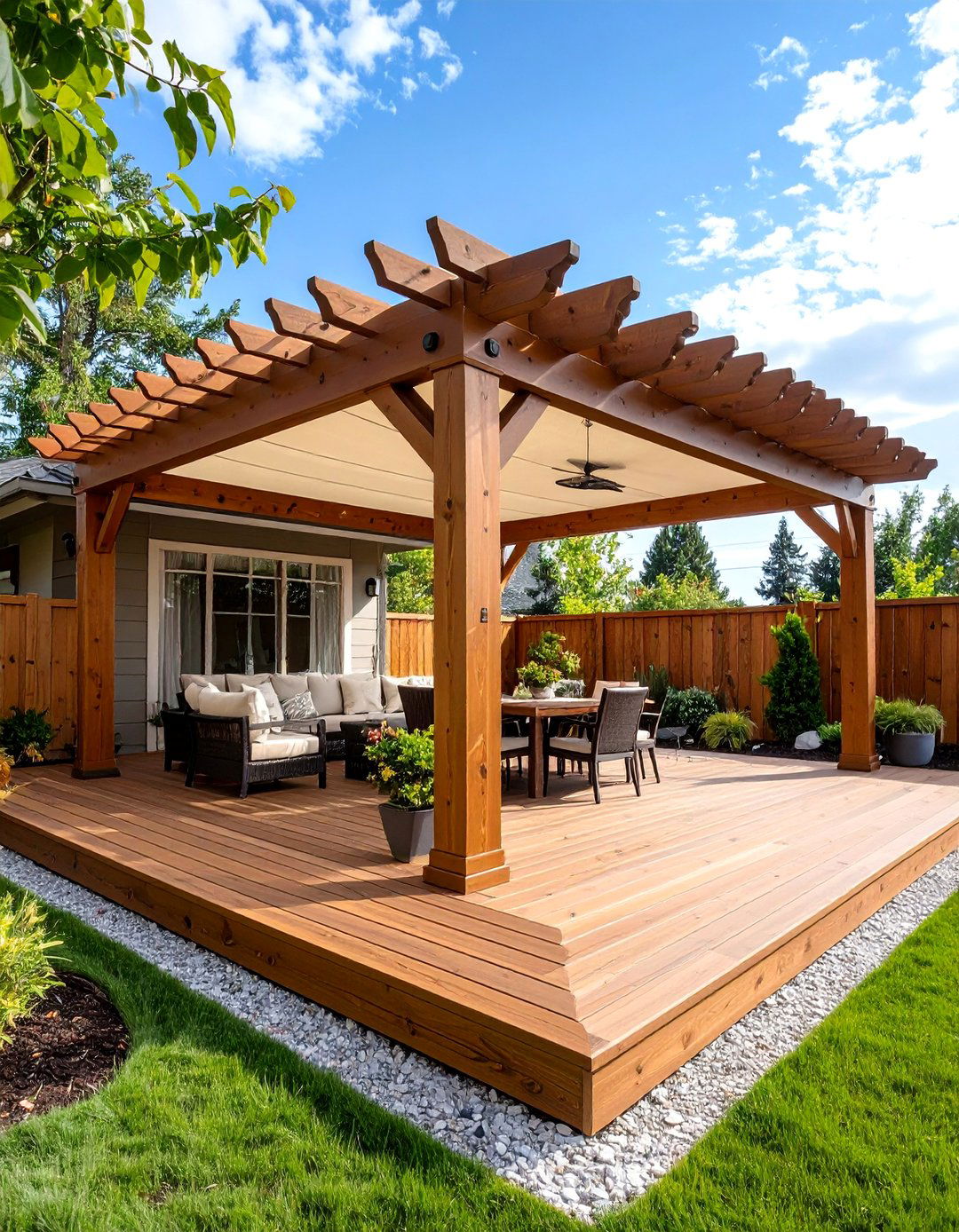
Adding a pergola to your composite deck creates an sophisticated outdoor room that provides shade, defines spaces, and adds vertical architectural interest to your design. Pergolas are an elegant addition to composite deck ideas and designs, offering both partial shade and an inviting architectural focal point. These structures work exceptionally well with composite decking because both materials offer low maintenance requirements and long-term durability. Quality structures like Trex® Pergola™ options add a variety of design benefits, such as: Enhanced dimension and texture, adding a vertical visual draw to your rooftop deck. Modern pergola systems offer customizable options including retractable canopies, integrated lighting, and motorized louvers for adjustable shade control. Add a pergola canopy, lighting, curtains, heaters or a fan to create the outdoor retreat of your dreams. The combination of composite decking and pergola structures creates a cohesive outdoor living environment that enhances both functionality and aesthetic appeal while requiring minimal ongoing maintenance.
11. Composite Deck Pool Surround
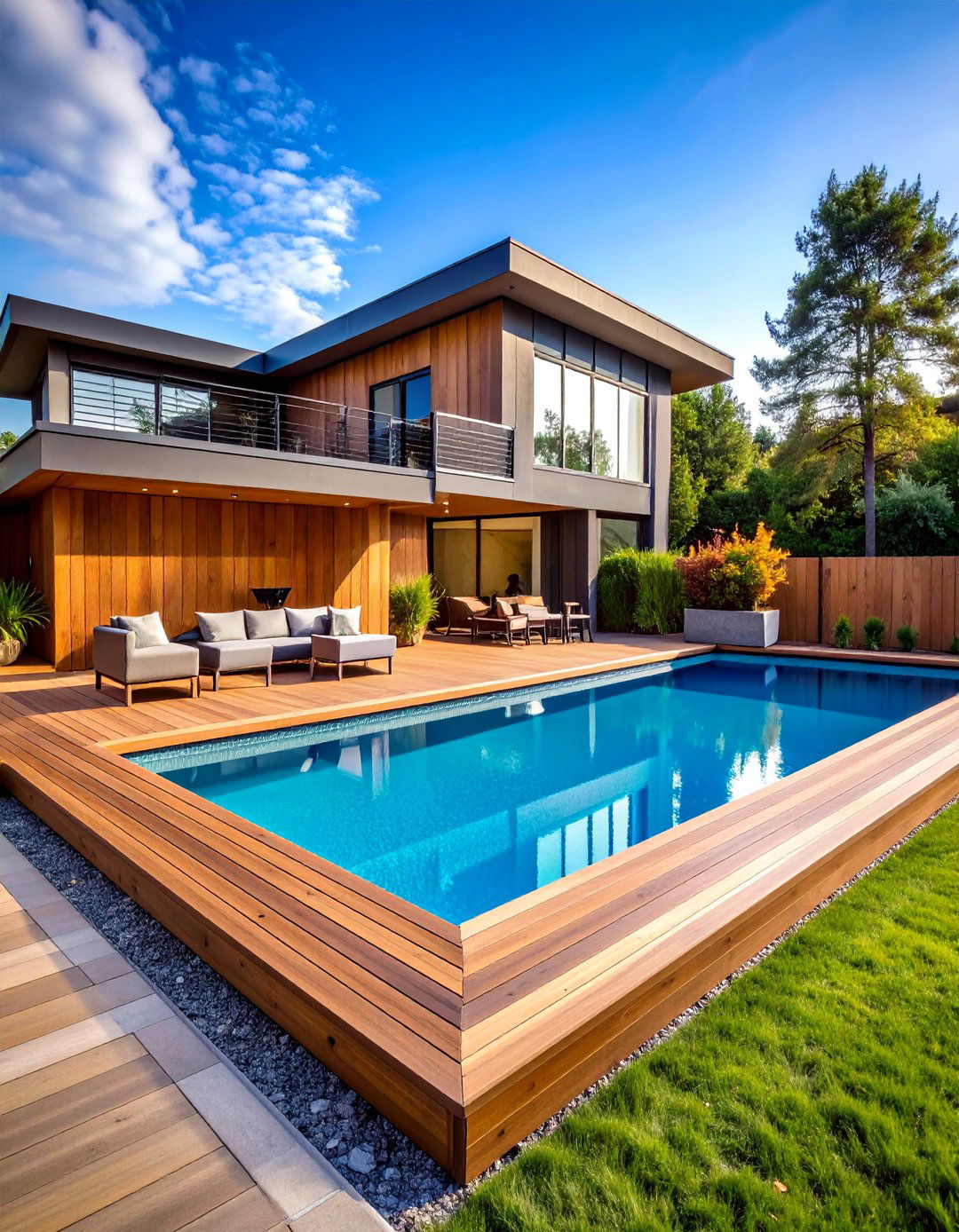
Composite deck pool surrounds create stunning aquatic environments that combine safety, beauty, and low maintenance for the ultimate backyard resort experience. A cozy, warm pool will allow you to relax and unwind. Create a tranquil area on composite decking boards to enjoy. The slip-resistant properties and heat resistance of quality composite materials make them ideal for pool areas where wet surfaces and intense sun exposure are common. A multi level deck is a great solution when you want to include a pool or hot tub in the design. One level can support the pool while the others feature seating or outdoor dining. Consider incorporating built-in seating, shade structures, and integrated storage for pool equipment and accessories. A cocktail railing is very useful on a deck. By laying a deck board over the top railing, you can turn an ordinary railing system into a useful addition. The consistent appearance and durability of composite materials create seamless transitions between pool areas and surrounding landscape elements.
12. Composite Deck Rooftop Design
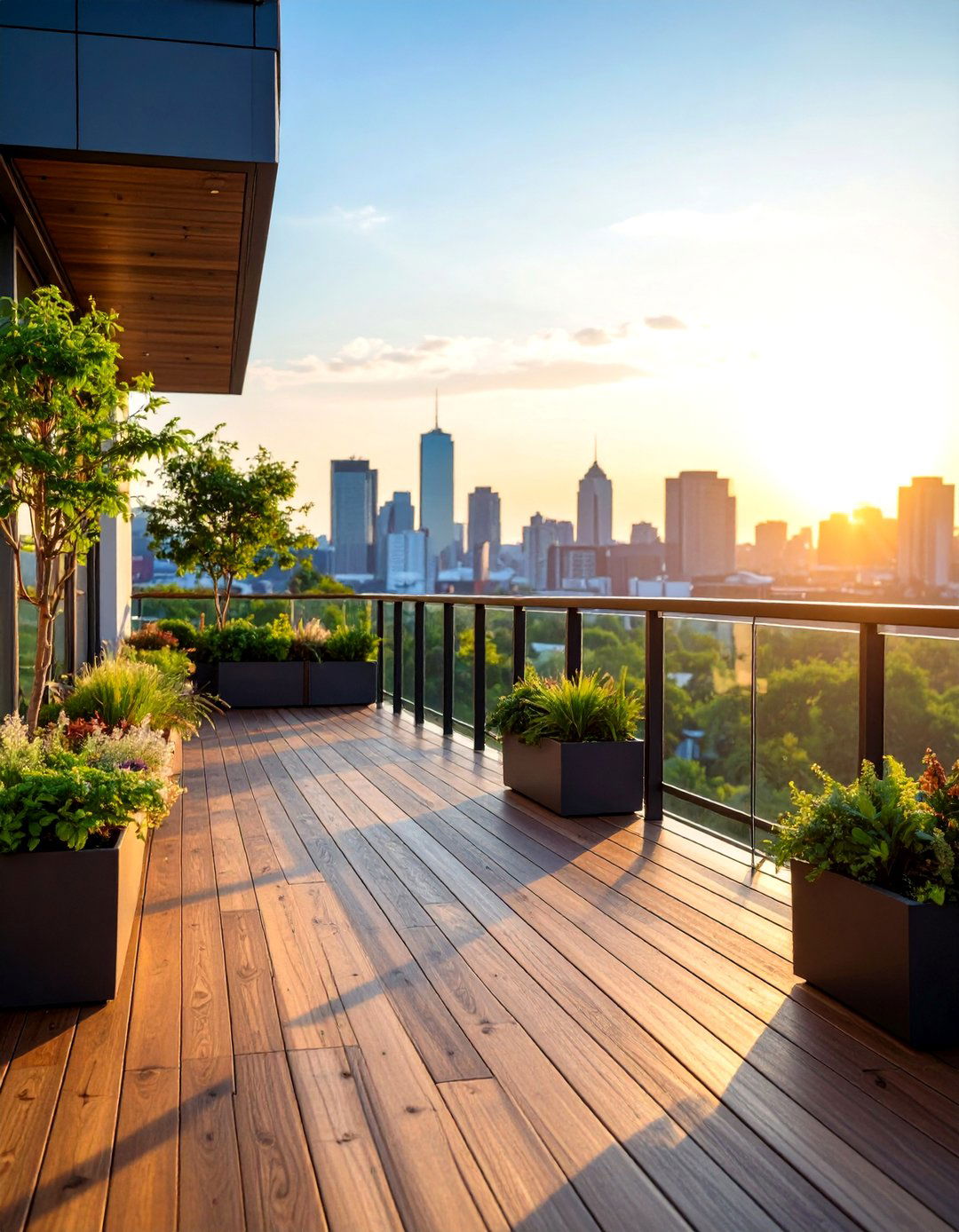
Rooftop composite decks maximize urban living space by transforming unused roof areas into spectacular outdoor retreats with panoramic views. Rooftop decks are one of the most popular ways to add extra outdoor living space to any home. Modern homes with rooftop decks can offer a relaxing sanctuary to entertain and enjoy the outdoors — all while making use of a spectacular view. The lightweight yet durable nature of composite materials makes them ideal for rooftop installations where weight considerations are critical. Use a see-through railing with a subtle metal grid or glass panel to ensure safety without compromising your view. These elevated spaces benefit from wind-resistant furniture, integrated planters for greenery, and weather-resistant shade solutions. Consider adding furniture with built-in storage to maximize space while improving your deck's practicality. Professional engineering ensures proper load distribution and weather protection while composite materials provide long-lasting beauty despite exposure to intense weather conditions at elevated heights.
13. Composite Deck Multi-Width Board Pattern
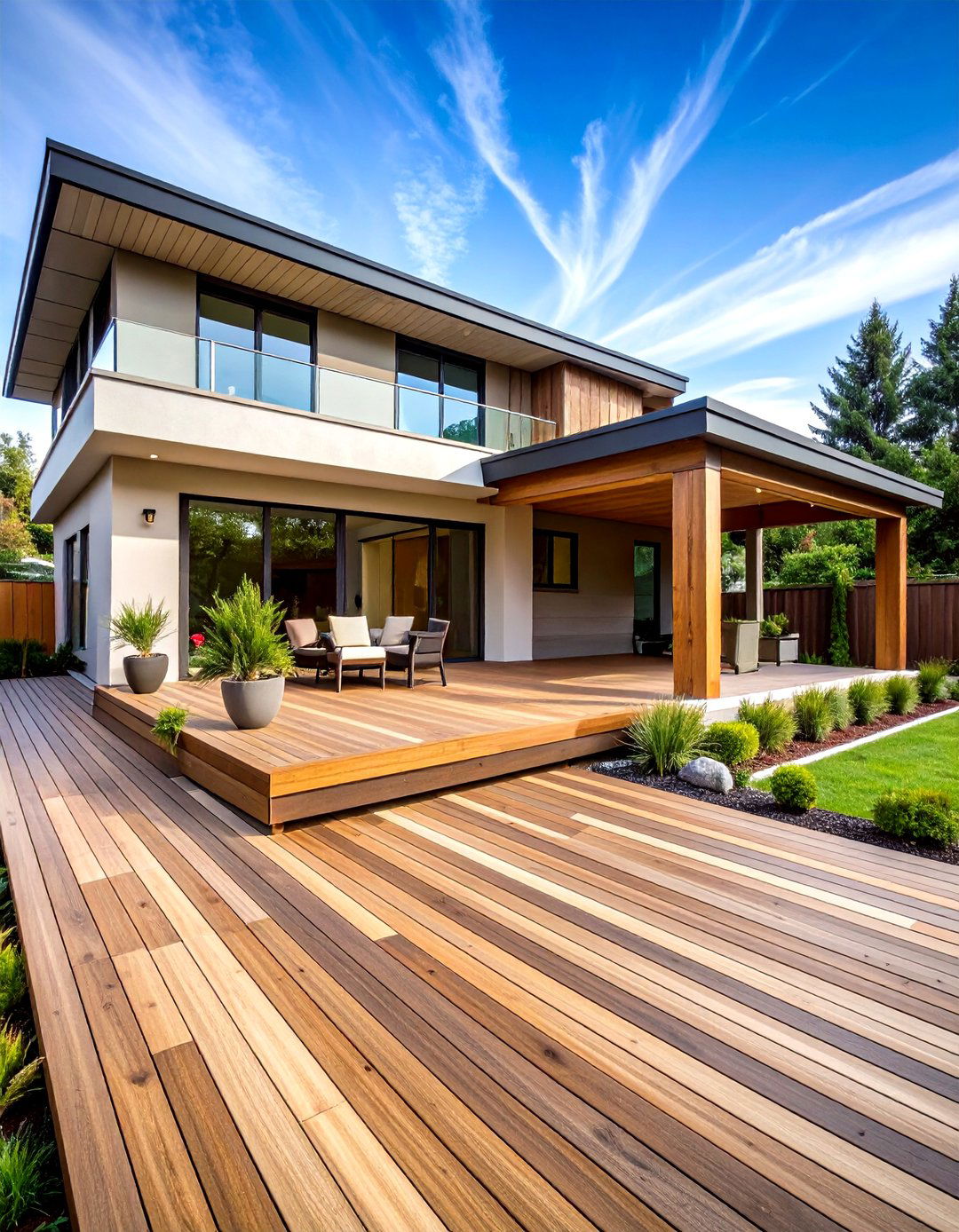
Multi-width composite deck board patterns create sophisticated visual texture and depth by combining different board widths in purposeful arrangements across your deck surface. Multi-width decking is available in our TimberTech Vintage Collection and Harvest Collection in three sizes: narrow (3.5 inches), standard (5.5 inches), and wide (7.25 inches). This design approach breaks up monotonous single-width installations while adding custom architectural interest that reflects personal style preferences. You can combine deck boards of different widths to add dimension or create patterns. The varied board widths can be arranged randomly for organic appeal or in systematic patterns for more formal appearances. Professional installation ensures proper joist spacing to accommodate different board widths while maintaining structural integrity. Keep in mind that more complex deck board patterns require extra joists which can increase the cost of your deck project. The resulting surface offers unique character that distinguishes your composite deck from standard single-width installations while maintaining the low-maintenance benefits of composite materials.
14. Composite Deck Chevron Pattern

Chevron composite deck patterns create striking geometric designs that add contemporary flair and visual movement to outdoor spaces through precise angular installations. A classic and playful chevron pattern combines diagonal decking with transition boards to create a simple angled design. It's similar to herringbone, but the pattern isn't quite as complex. This sophisticated pattern involves boards meeting at sharp angles to form continuous V-shapes across the deck surface, creating dynamic visual flow. The chevron deck pattern is often viewed as a simplified version of the herringbone pattern, sharing a similar historical heritage and a highly coveted geometric design. While requiring careful planning and precise cutting, chevron patterns are more achievable than complex herringbone designs for skilled DIY enthusiasts. It consists of V-shaped formations, adding a geometric and artistic touch to your outdoor space. It is a great way to introduce a sense of movement and direction. The resulting composite deck surface combines modern aesthetics with timeless geometric appeal.
15. Composite Deck Floating Design
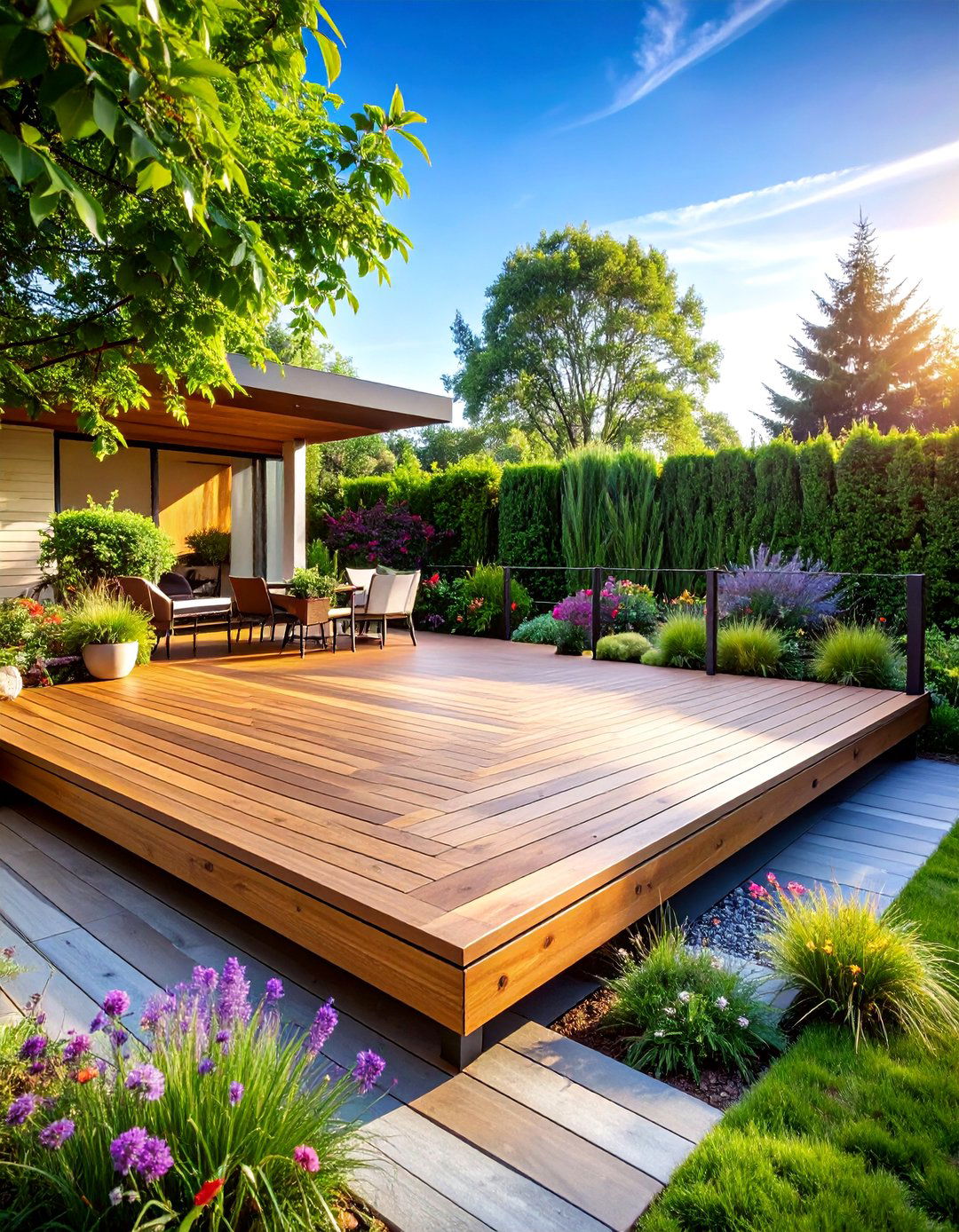
Floating composite deck designs offer flexible, ground-level outdoor living solutions that appear to hover just above the landscape without permanent foundation attachments. A floating deck looks like its floating just above ground. These freestanding structures provide design freedom since they're not attached to existing buildings, allowing placement anywhere in your yard for optimal sun exposure or views. Transforming your outdoor space into a seamless extension of your home starts with the right ground-level deck design. The low-profile design typically eliminates the need for stairs or complex railing systems while providing stable, level surfaces for outdoor furniture and activities. Because they are so low, they often don't even require stairs, meaning you have the freedom to place your pergola on a floating deck anywhere you want to create a little island of relaxation right in your garden. Composite materials excel in floating deck applications due to their resistance to ground moisture and temperature fluctuations while maintaining structural integrity over time.
16. Composite Deck Privacy Wall Integration
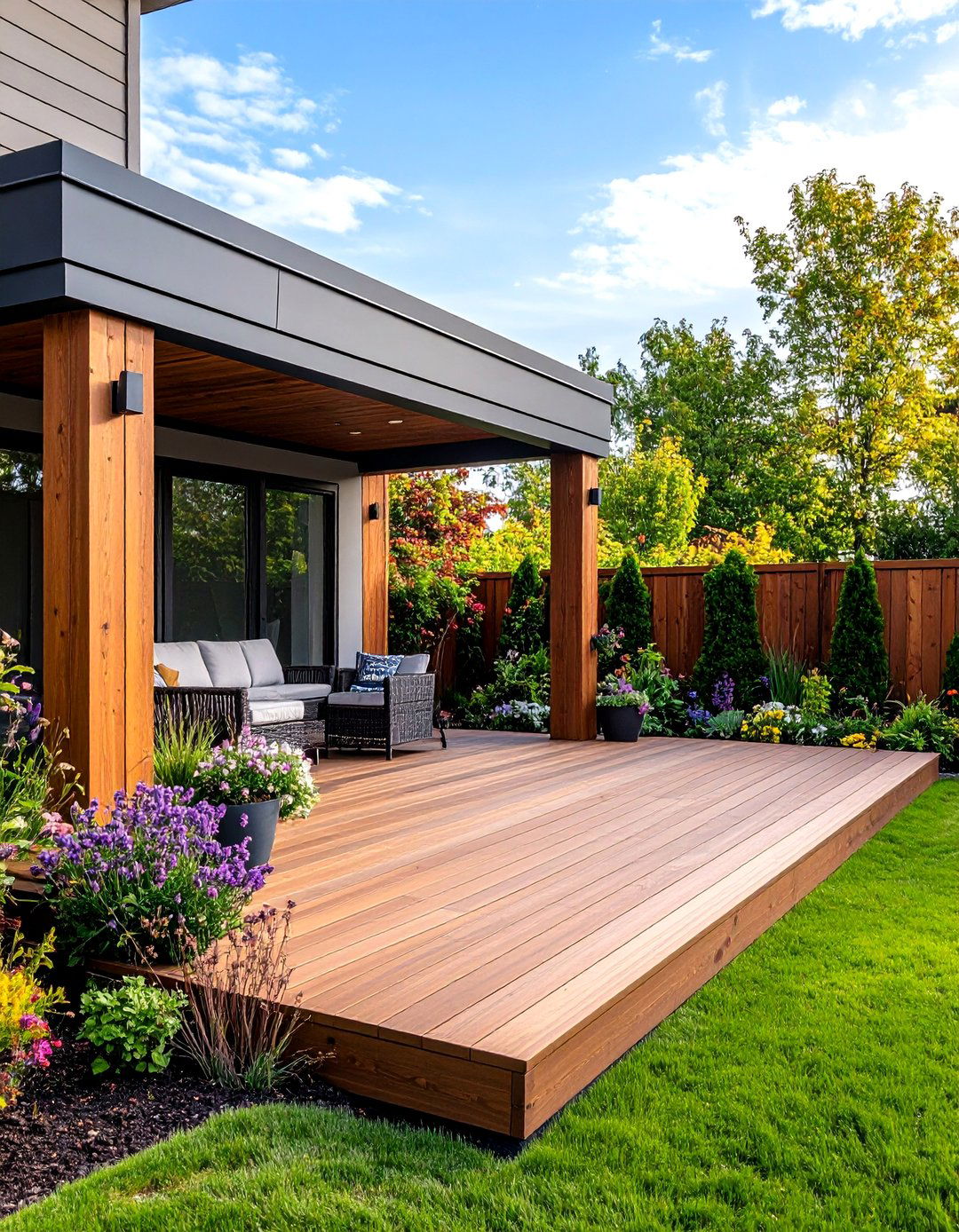
Privacy wall integration with composite decking creates intimate outdoor spaces that provide seclusion from neighbors while maintaining aesthetic cohesion throughout your design. Think outside the box and turn decking on its side to create the perfect privacy wall. It's a great way to protect your space from nosy neighbors in a style all your own. These vertical applications of composite materials can incorporate matching textures and colors to create seamless transitions between horizontal deck surfaces and vertical privacy elements. Planters and Privacy Walls: Add a touch of greenery with built-in planters or create secluded spaces with custom privacy walls made from composite materials for a cohesive look. Consider combining solid composite panels with integrated planters or decorative screening elements to soften harsh lines while maintaining privacy. The weather-resistant properties of composite materials ensure long-lasting privacy solutions that require minimal maintenance compared to traditional wood fencing. Strategic placement of privacy walls can create distinct outdoor rooms for different activities while enhancing the overall functionality of your composite deck space.
17. Composite Deck Tile Pattern Design
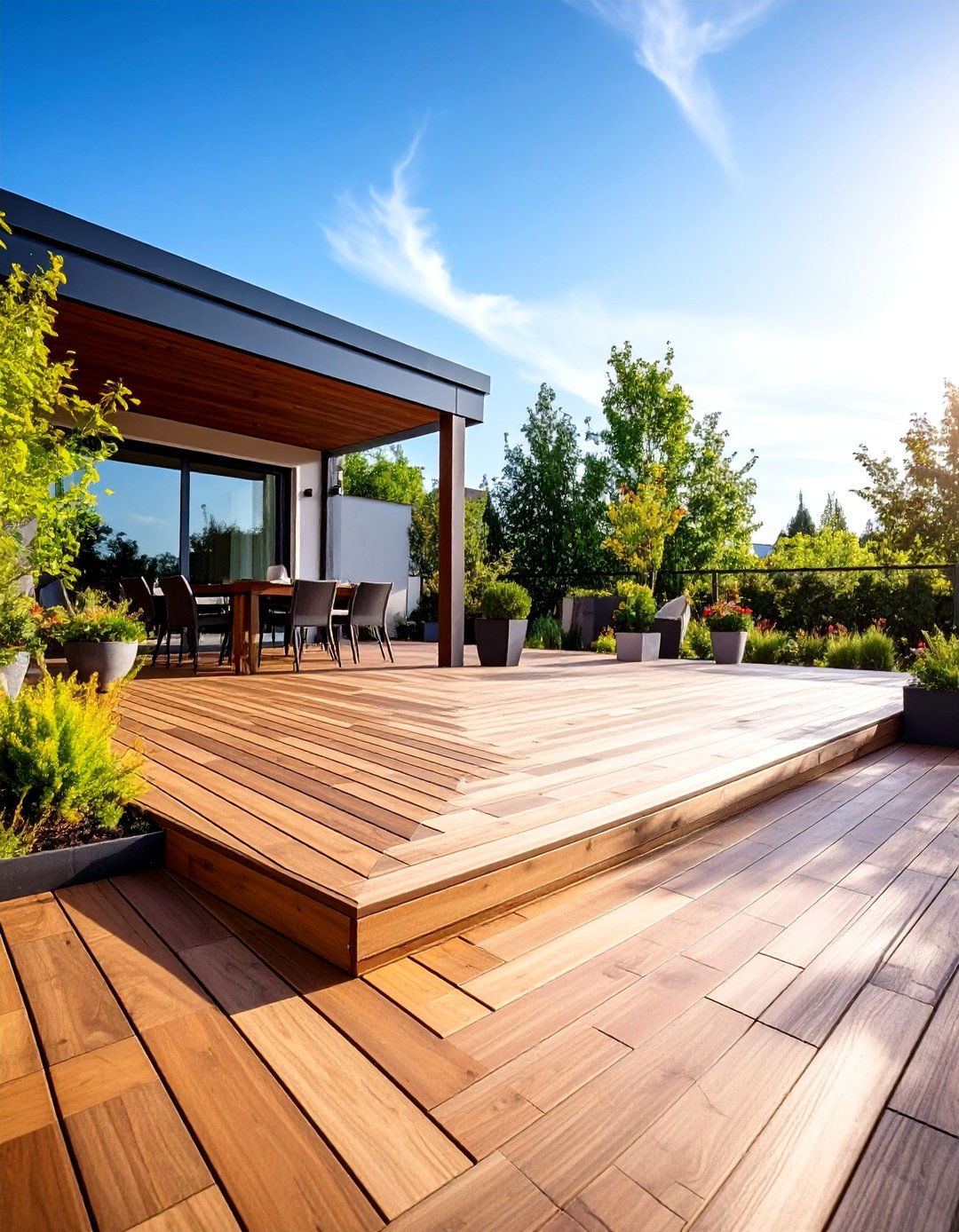
Tile pattern composite deck designs create sophisticated geometric arrangements using framed sections that run perpendicular to each other for striking visual appeal. Tile deck patterns use adjoining framed portions ("tiles") with inlays that run perpendicular to one another. The geometric design is pleasing to the eye, and the crisp right angles convey precision and intentionality. This advanced pattern technique involves creating individual deck "tiles" separated by transition boards that frame each section distinctly. Tile deck patterns create a pattern of squares or rectangles by separating sections of deck with a framed grid. The systematic approach allows for creative color combinations within each tile section while maintaining overall design cohesion. Professional installation ensures proper structural support for the complex framing requirements while achieving precise alignment between tile sections. They offer the opportunity to get creative with the tile inlays themselves, as well as the potential to add punch with contrasting colors. The resulting composite deck surface resembles high-end interior flooring while providing outdoor durability and weather resistance.
18. Composite Deck Two-Tone Color Scheme

Two-tone composite deck color schemes create sophisticated depth and visual interest by strategically combining complementary or contrasting board colors throughout your outdoor space. One popular trend in deck design is to use dual tones to add depth and dimension to your outdoor space. We're seeing more light browns and grays where we used to install darker decking. This design approach works particularly well with picture frame patterns, borders, and accent details that highlight architectural features. No two composite decks need to be alike. Unlike wood, composite decking comes in a variety of rich colors that allow you to customize your space. The color combinations can range from subtle tonal variations to bold contrasts that create dramatic focal points and define different activity zones. Mixing board colors can enhance visual interest and create distinct zones within your deck. A picture frame or transition board layout is perfect for incorporating contrasting colors. Professional design consultation helps ensure color combinations complement your home's architecture while creating the desired visual impact for your composite deck investment.
19. Composite Deck Under-Deck Storage
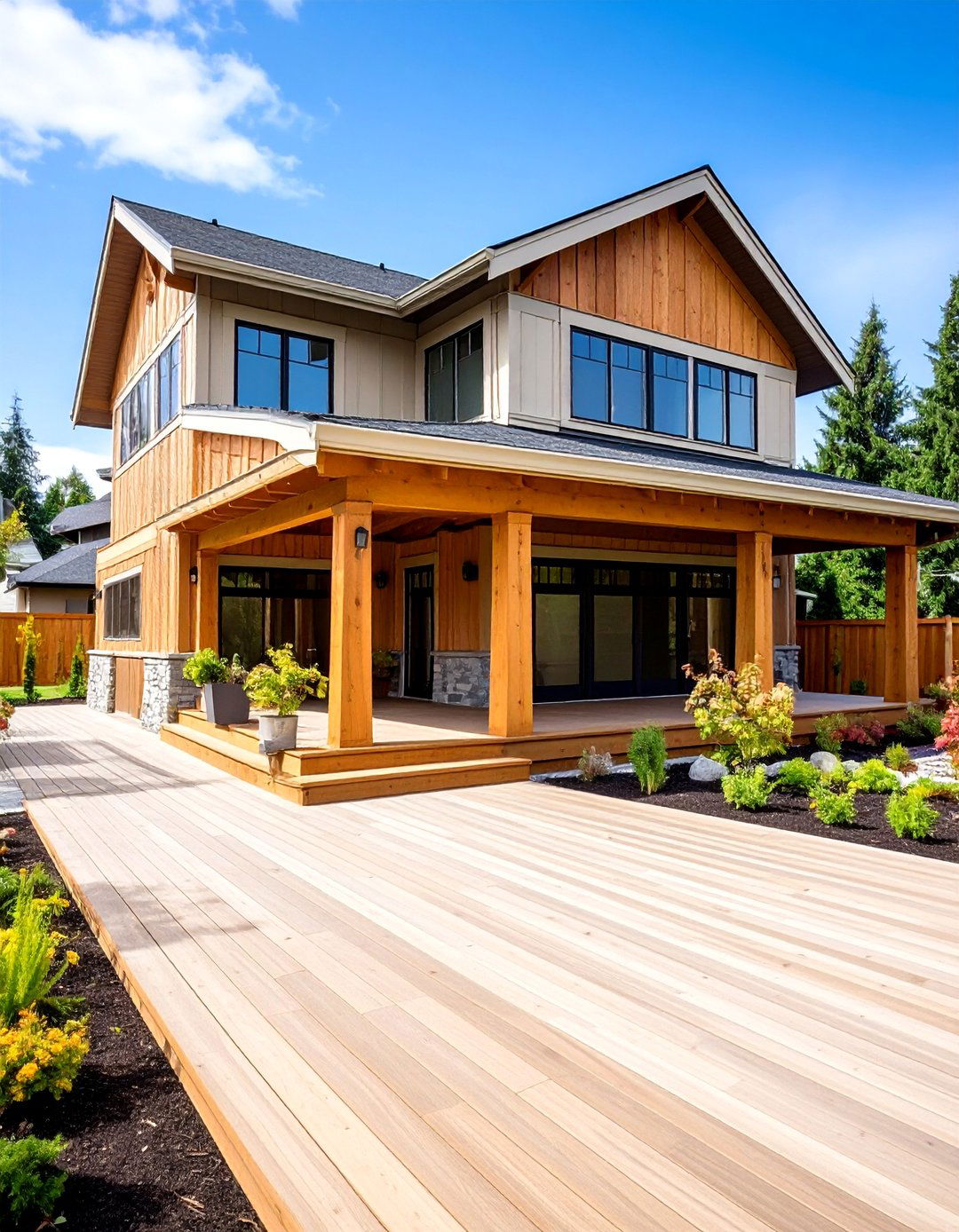
Under-deck storage integration maximizes space efficiency by transforming unused areas beneath elevated composite decks into functional storage and covered outdoor rooms. One of the key benefits of a second-story deck is the ability to create under-deck living and storage areas. By installing a proper drainage system, you can transform the space underneath your upper deck into a covered patio or outdoor living room. These spaces can accommodate outdoor furniture during off-seasons, garden tools, recreational equipment, and other items that benefit from weather protection. Built-in features take composite deck ideas to the next level, combining convenience with sleek design. These additions eliminate the need for bulky furniture or add-ons, creating a clutter-free and highly functional outdoor space. Proper drainage systems prevent water accumulation while maintaining structural integrity of your composite deck above. The enclosed under-deck areas can include lighting, electrical outlets, and even climate control for year-round storage solutions. Professional installation ensures proper weatherproofing and access while maintaining the aesthetic appeal of your composite deck design.
20. Composite Deck Garden Integration
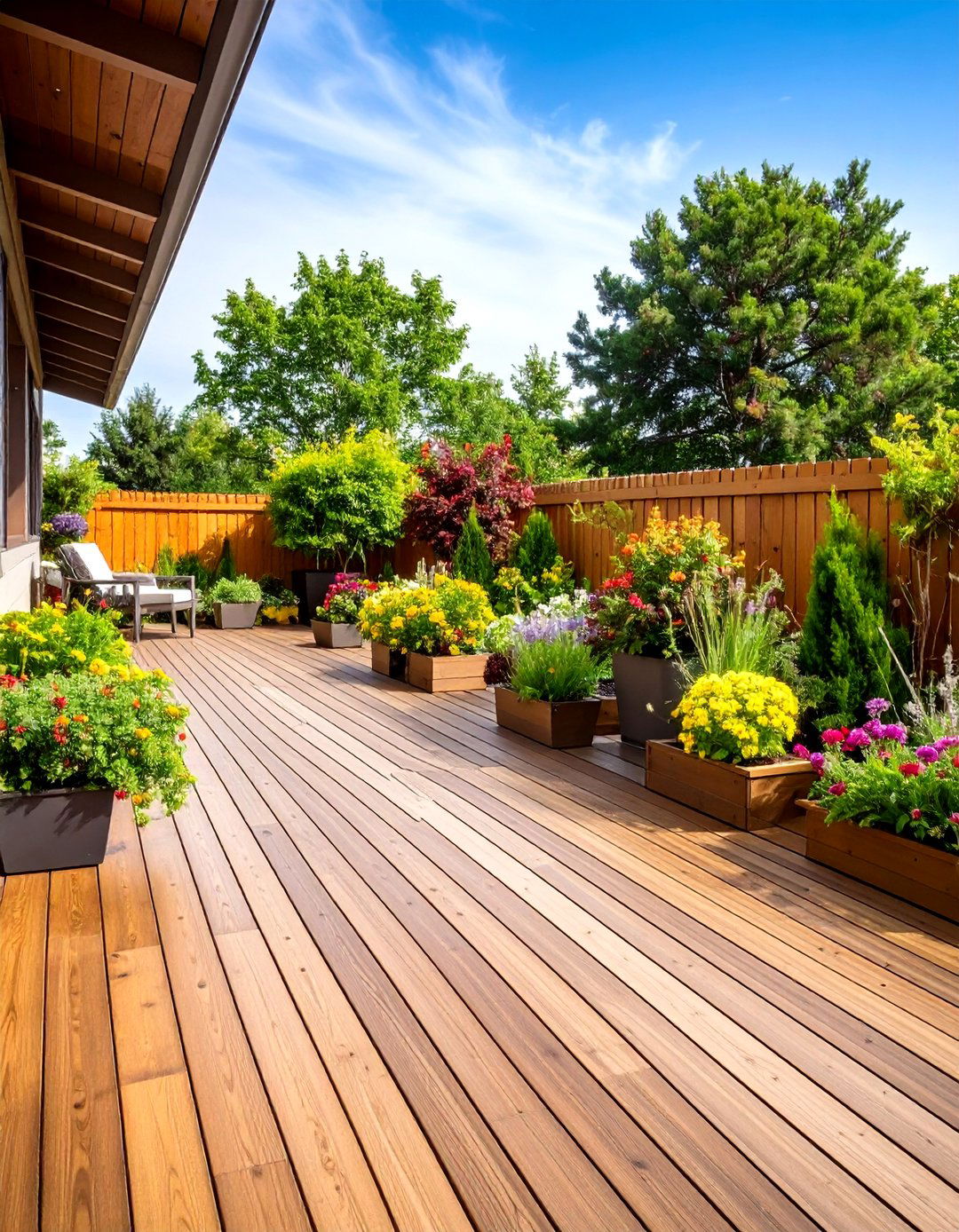
Garden-integrated composite decks create harmonious outdoor environments that seamlessly blend natural landscaping with architectural elements for complete outdoor living experiences. A garden-integrated deck beautifully combines nature with functionality. By incorporating planters, flower beds, or even a small vegetable garden, the deck becomes an extension of your landscaping. Built-in planters using matching composite materials maintain design consistency while providing growing space for flowers, herbs, or decorative plants. You can plant evergreen bamboo around the deck or place some evergreen potted plants on top of the deck planter boxes. This backyard deck design seems to be designed with attractive plants in mind, making it feel like the deck is part of nature. Strategic placement of garden elements creates natural privacy screens, seasonal color interest, and connection to the surrounding landscape. Use natural materials like wood to complement the greenery and consider adding trellises or climbing plants for an extra touch of charm. The low-maintenance composite materials complement garden integration by requiring minimal upkeep, allowing more time for gardening activities and outdoor enjoyment.
Conclusion:
Composite deck designs offer endless possibilities for creating stunning, functional outdoor spaces that enhance your lifestyle while providing exceptional durability and low maintenance. From intricate herringbone patterns to modern multi-level designs, these versatile materials adapt to any architectural style or personal preference. The combination of aesthetic appeal, weather resistance, and minimal upkeep requirements makes composite decking an excellent investment for homeowners seeking long-term outdoor living solutions. With a well-designed multi-level composite deck, you can transform your outdoor space into a stunning oasis that provides years of enjoyment and adds significant value to your home. Whether incorporating fire features, outdoor kitchens, or integrated lighting, composite decks provide the perfect foundation for creating your ideal outdoor retreat.


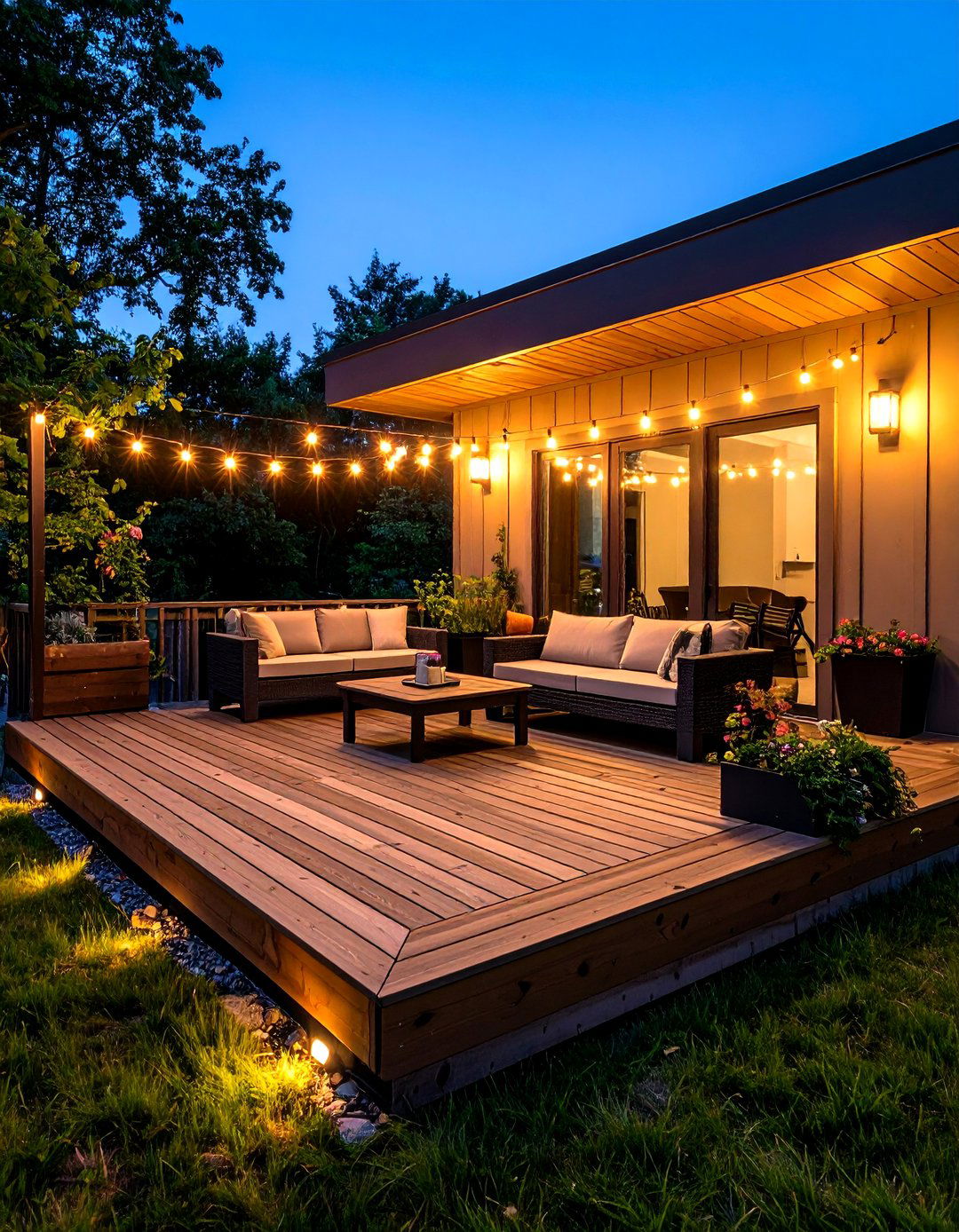
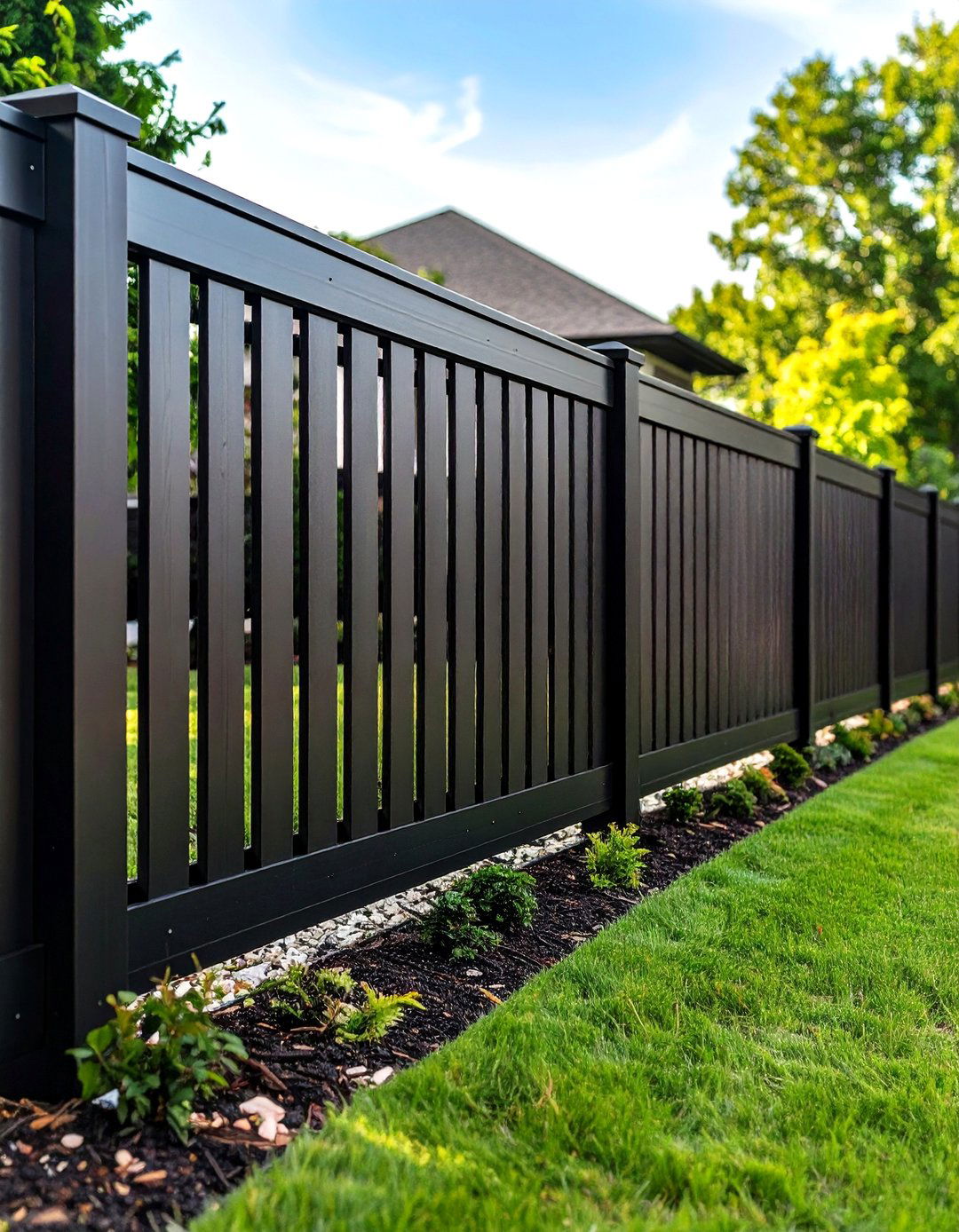


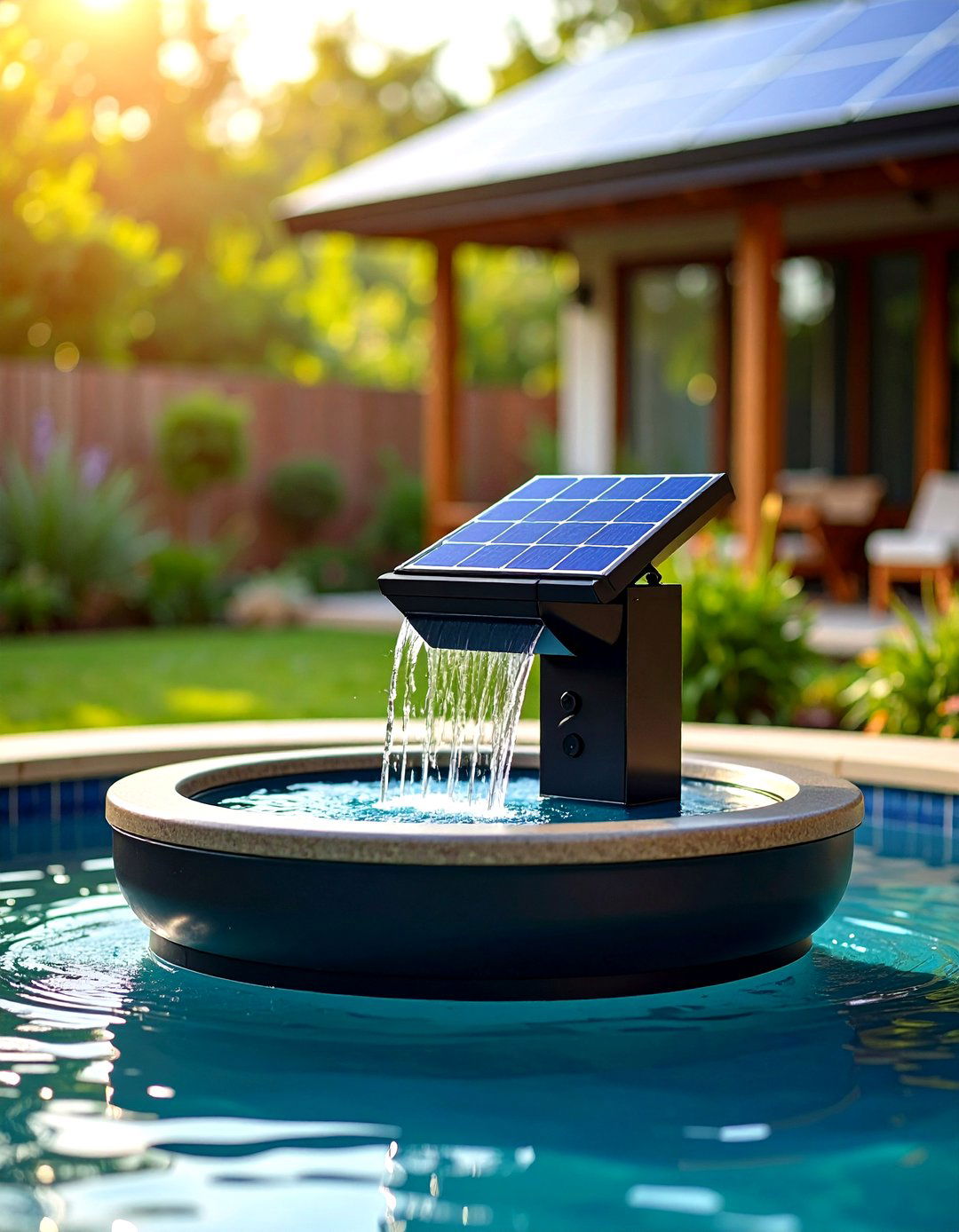
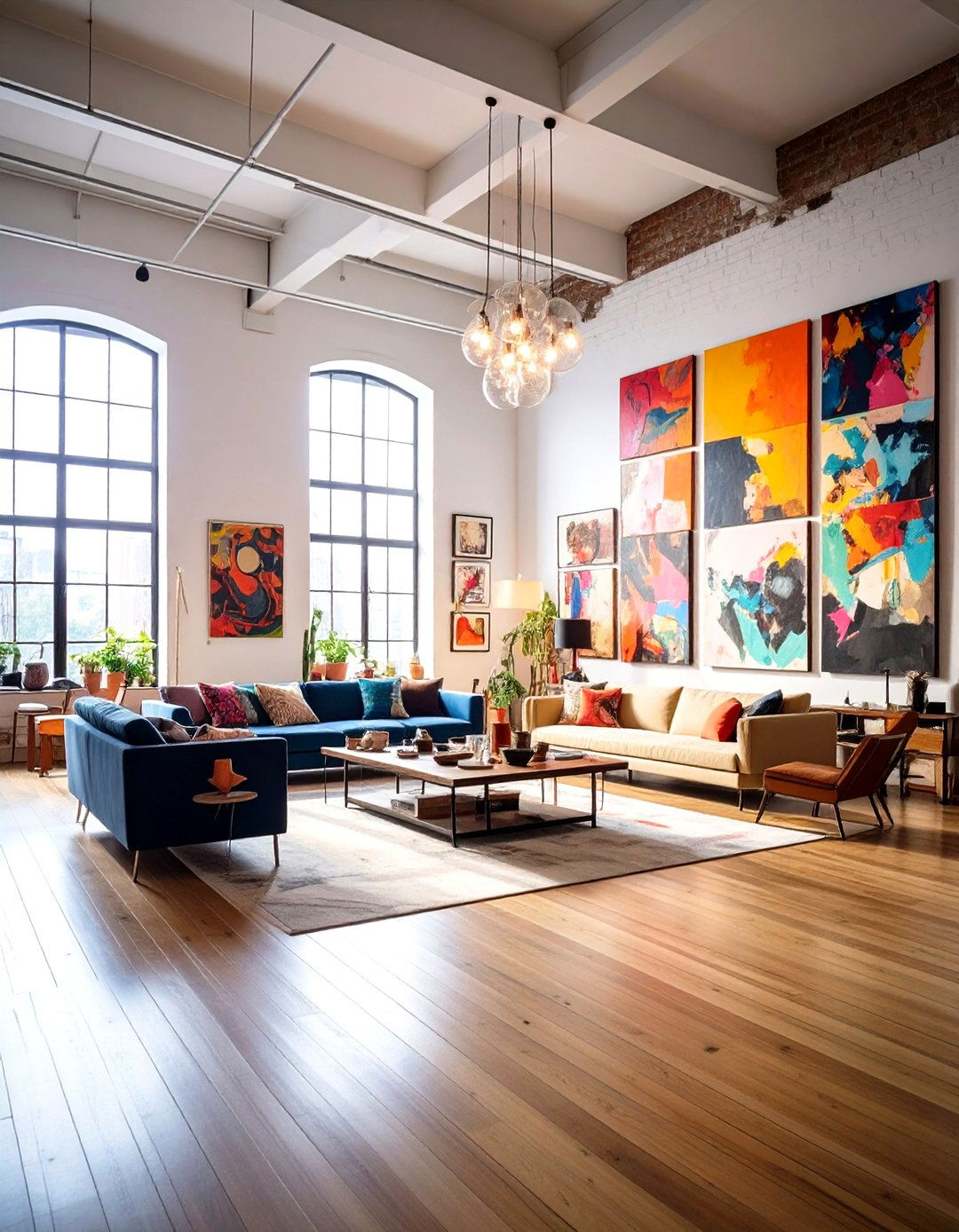
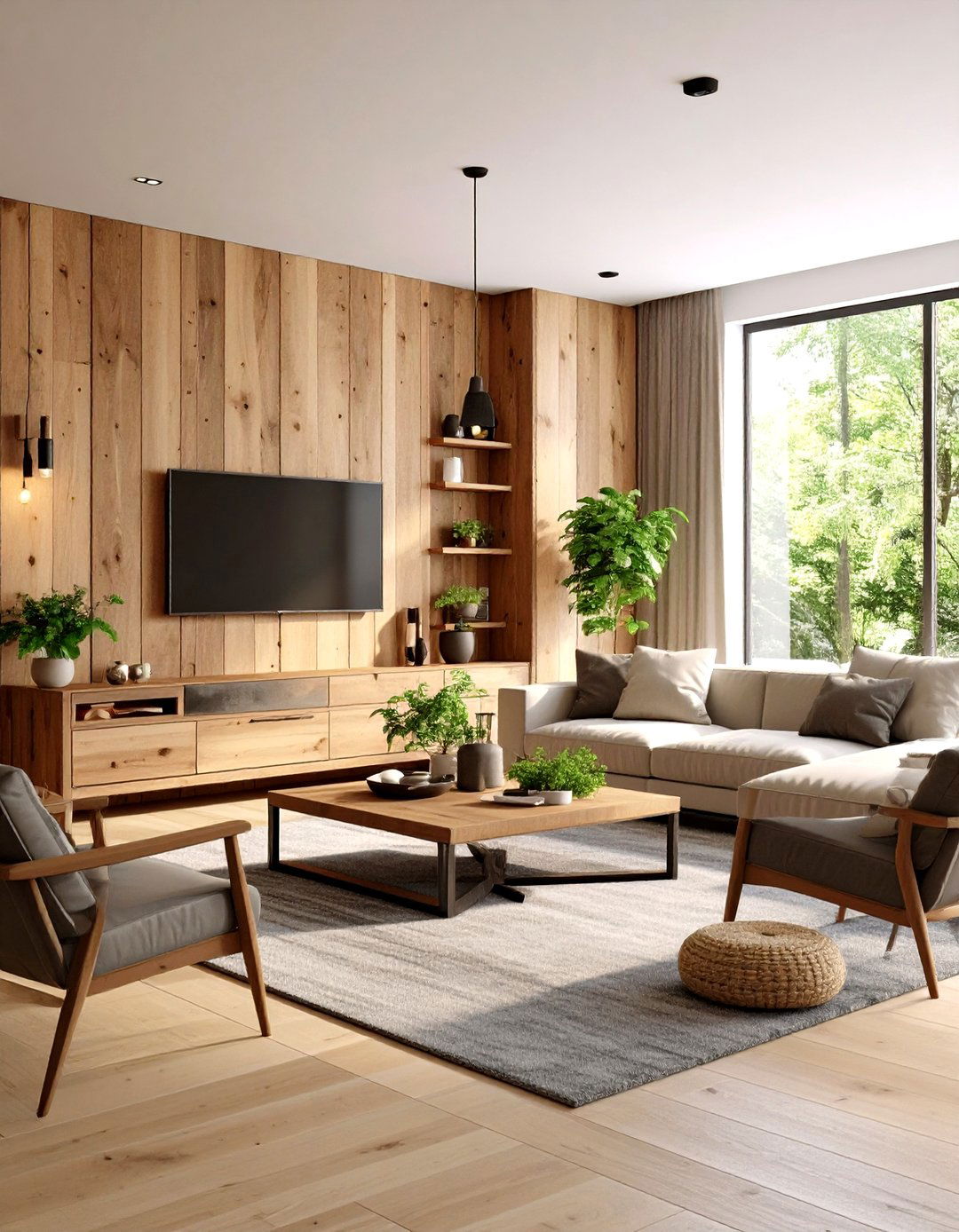
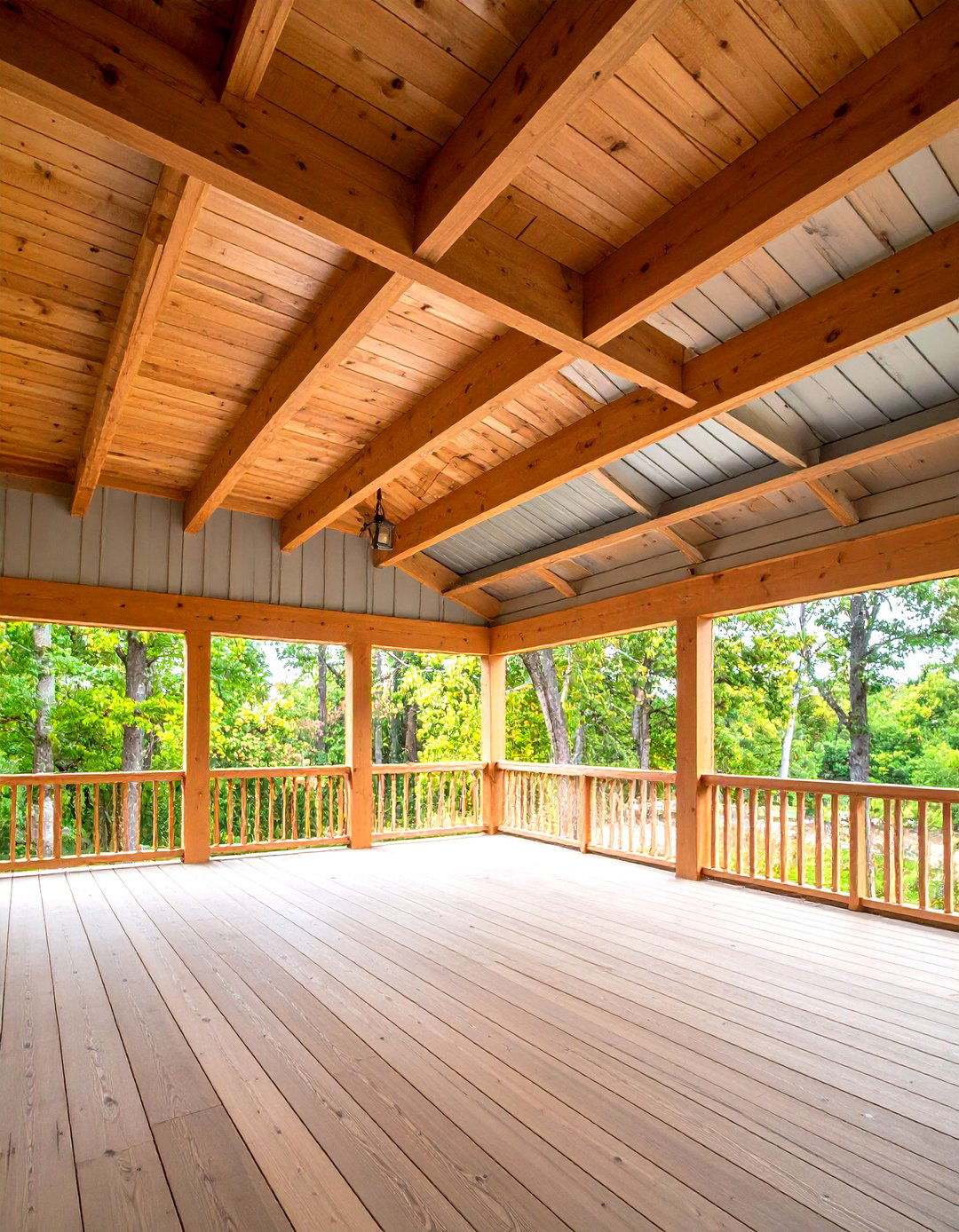
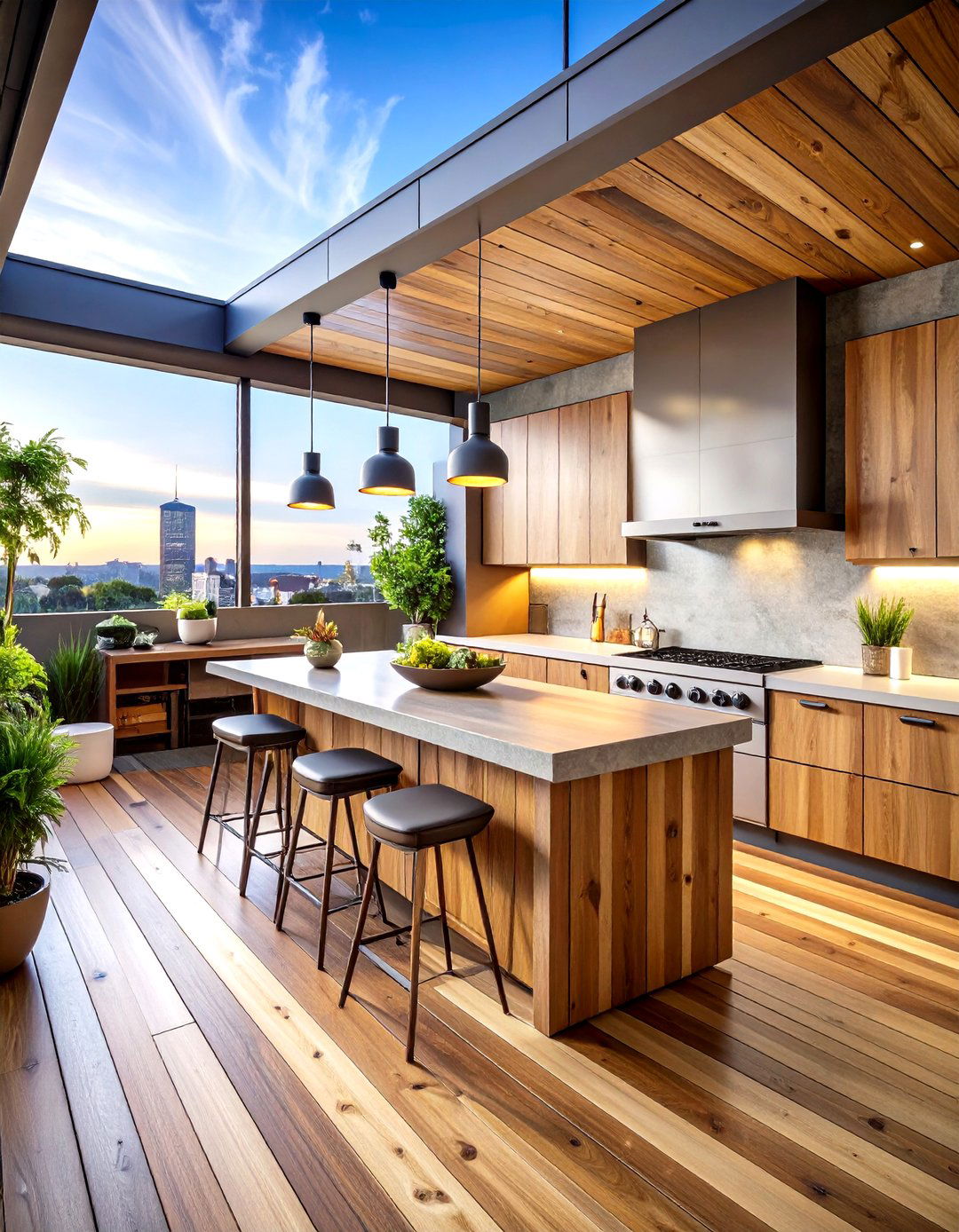
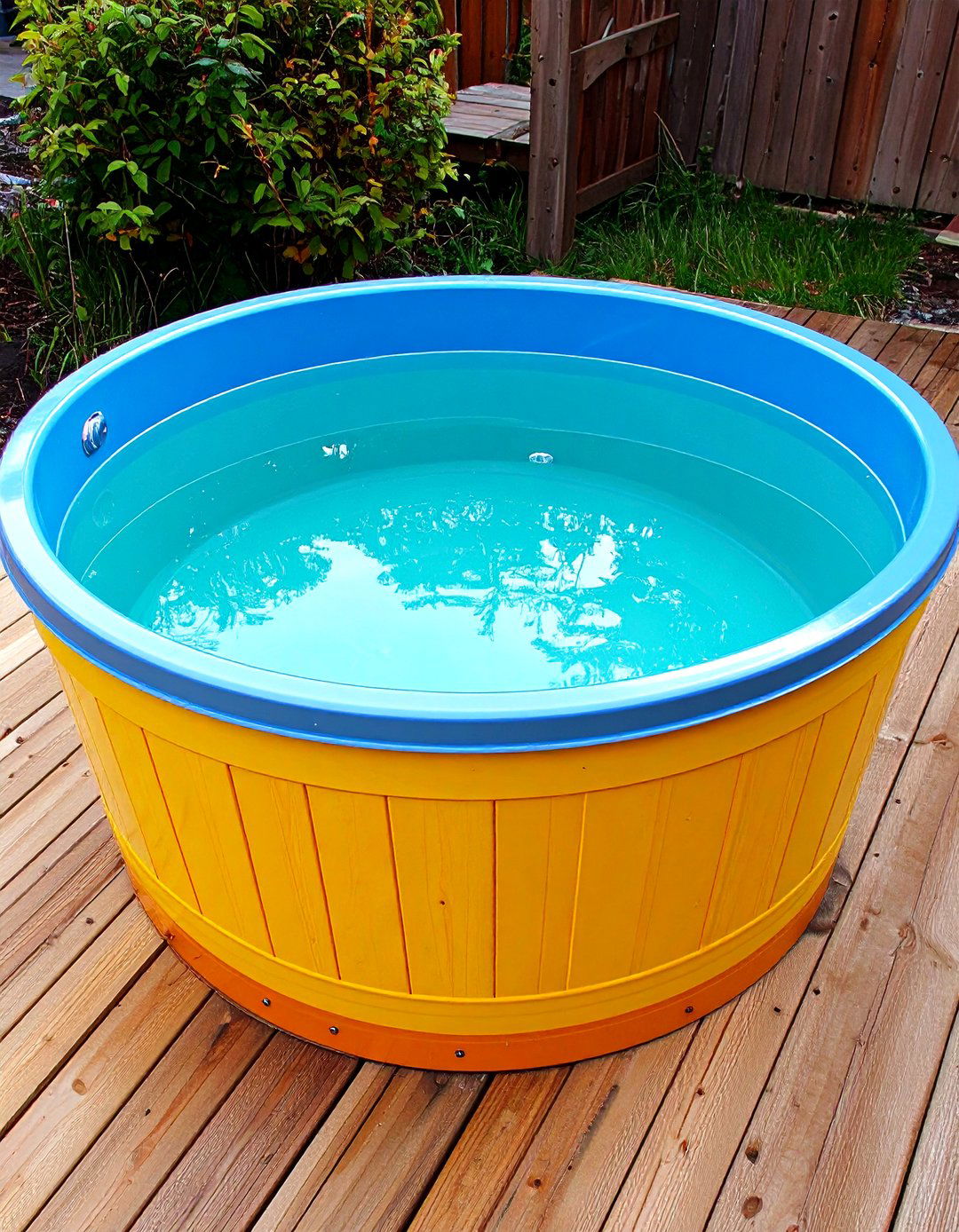

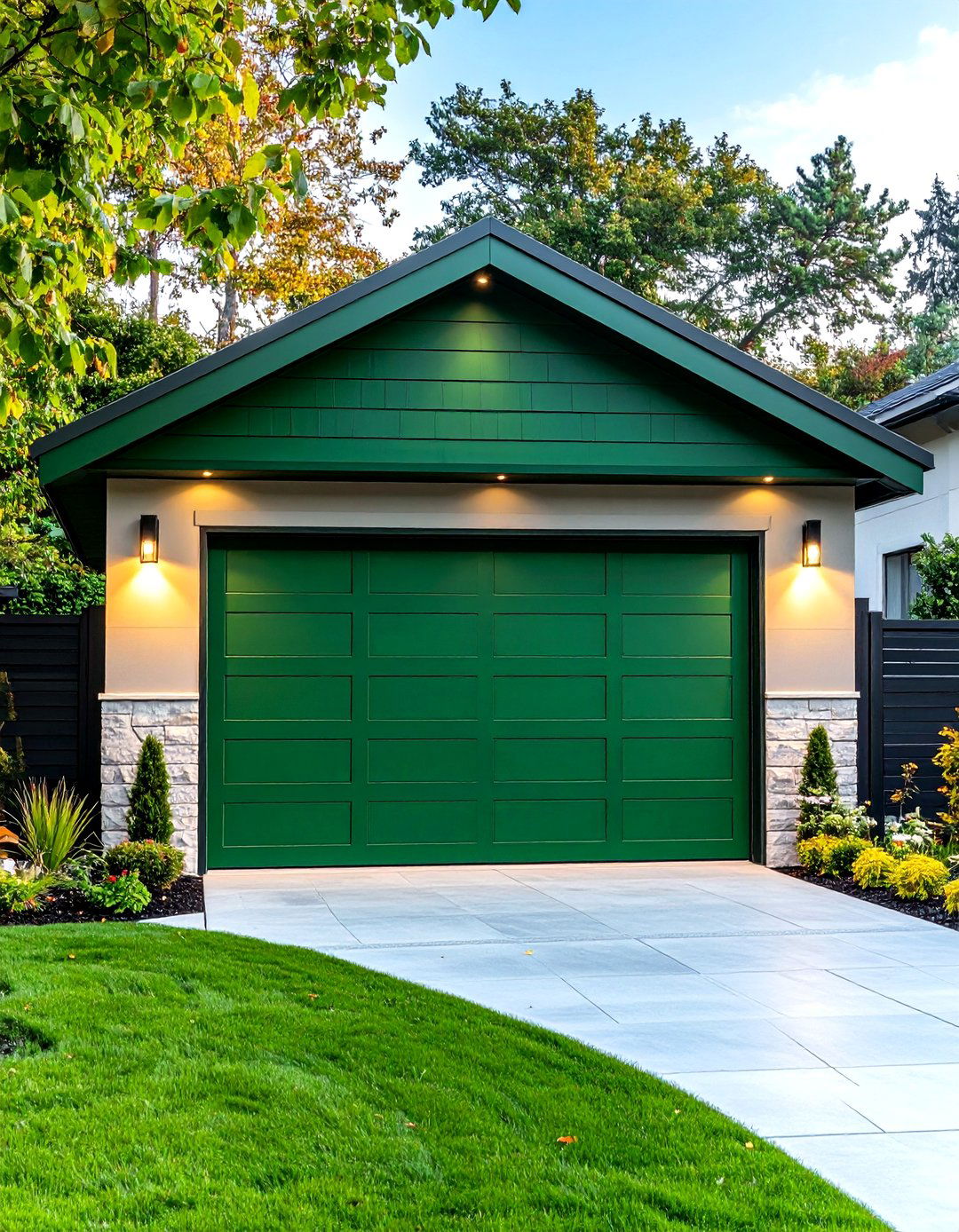
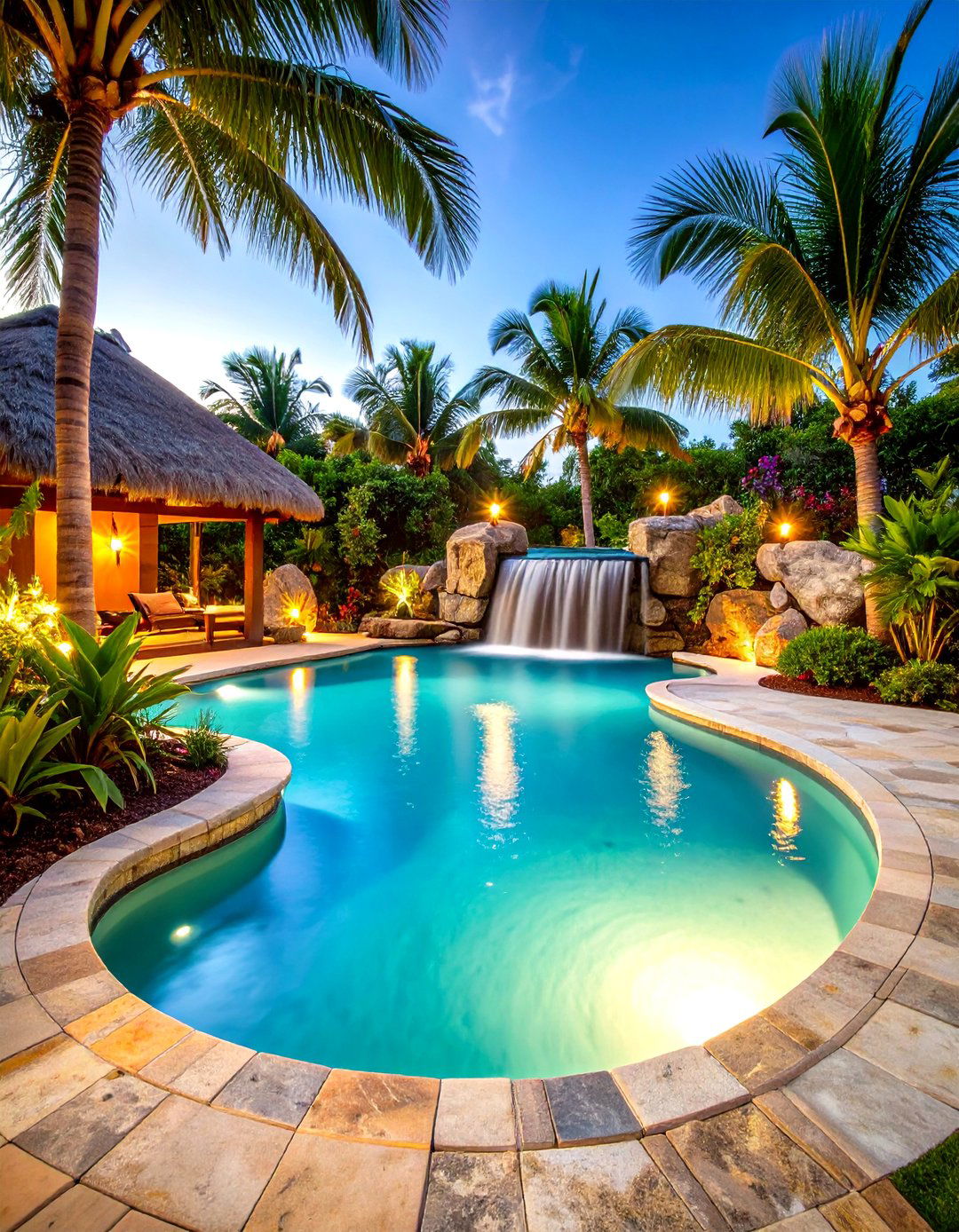

Leave a Reply